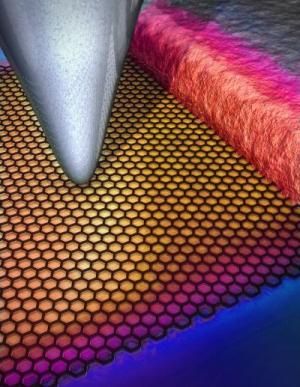Heat is a sad fact of life for current generation electronics. Any Android, iPhone, or BlackBerry user can tell you that smartphones tend to get pretty hot at times. And by today's standards a balmy 85 degrees Celsius, while hot enough to cook an egg, is a pretty "good" operating temperature for a high-powered PC graphics processing unit.
But that could all soon change, according to the results of a new study by researchers at the University of Illinois. Examining graphene transistors, a team led by mechanical science and engineering professor William King [profile] and electrical and computer engineering professor Eric Pop [profile] made a remarkable discovery -- graphene appears to self-cool.
I. What is Graphene?
Graphene is somewhat like a miniature "fence" of carbon. The material consists of a single-atom thick layer composed of hexagonal units. At each point of the hexagon sits a carbon atom that is bonded to its three close neighbors.
The material behaves like a semiconductor, despite being made of organic atoms. It offers remarkable performance at an incredibly small scale, thus the electronics industry views it as a potential material to power electronic devices of the future.
A variety of methods exist for producing graphene. The earliest method was an exfoliation technique that involved stripping individual graphene layers off a layer of graphite (the material found in pencil lead) -- this technique (as of 2008) cost as much as $100M USD to produce a single cubic centimeter of material. However, rapid advances in production have allowed manufacturers to begin scaling up production to the point where tons of exfoliated graphene can now be produced.
Other techniques promise to drop the price even further. One method, epitaxial growth on silicon cost $100 per cubic centimeter in 2009. Its limitation is that, obviously, it requires silicon (eliminating some desirable properties like flexibility). South Korean researchers have tested another promising method, nickel metal transfer.
Graphene is fascinating from a physics perspective. In 2005 physicists at the University of Manchester and the Philip Kim group from Columbia University demonstrated that quasiparticles inside graphene were massless Dirac fermions. These unusual particles help give rise to the material's unique characteristics.
II. Graphene as a Self-Cooling Device

Overcoming technical challenges, the University of Illinois team used an atomic force microscope tip as a temperature probe to make the first nanometer-scale temperature measurements of a working graphene transistor.
What they found was that the resistive heating ("waste heat") effect in graphene was weaker than its thermo-electric cooling effect at times. This is certainly not the case in silicon or other semiconductors where resistive heating far surpasses cooling effects.
What this means is that graphene circuits may not get hot like traditional silicon-based ones. This could open the door to dense 3D chips and more.
Further, as the heat is converted back into electricity by the device, graphene transistors may have a two-fold power efficiency gain, both in ditching energetically expensive fans and by recycling heat losses into usable electricity.
Professor King describes, "In silicon and most materials, the electronic heating is much larger than the self-cooling. However, we found that in these graphene transistors, there are regions where the thermoelectric cooling can be larger than the resistive heating, which allows these devices to cool themselves. This self-cooling has not previously been seen for graphene devices."
Professor Pop adds, "Graphene electronics are still in their infancy; however, our measurements and simulations project that thermoelectric effects will become enhanced as graphene transistor technology and contacts improve."
A paper has been published [full text] in nanotechnology's most prestigious peer-reviewed journal, Nature Nanoscience. University of Illinois graduate student Kyle Grosse [profile], undergraduate Feifei Lian and postdoctoral researcher Myung-Ho Bae are listed as co-authors on the paper.
III. What's Next?
The study should provide even more motivation for semiconductor manufacturing companies like Intel, GlobalFoundries, and TMSC to lay down the process work necessary to mass-produce circuits based on graphene transistors, capacitors, etc.
As for the University of Illinois team, they plan to next use their new measurement technique to analyze carbon nanotubes and other novel structures that are of interest to future electronics applications.
Their work is funded via a grant from the Air Force Office of Scientific Research and the Office of Naval Research.




The next step in semiconductors -- pretty exciting...
"Their work is funded via a grant from the Air Force Office of Scientific Research and the Office of Naval Research. "
And those two agencies are funding this research for the benefit of humanity...right?